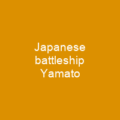Operation Ten-Go: A Last Stand in the Pacific
Imagine a final, desperate gamble in the vast expanse of the Pacific Ocean during World War II—this is Operation Ten-Go. In April 1945, as Allied forces closed in on Okinawa, Japan launched its last major naval operation. The Yamato, one of the largest battleships ever built, and nine other warships embarked on a suicide mission against the U.S. fleet. But what was this operation really about? Was it just a futile attempt to delay the inevitable, or did it hold deeper significance?
The Prelude: A Last Hope
Before Operation Ten-Go, the Imperial Japanese Navy’s Combined Fleet had been reduced to a mere handful of operational warships and aircraft. In March 1945, military leaders briefed Emperor Hirohito on their response to the expected invasion of Okinawa. The plan was clear: extensive air attacks and kamikaze tactics would be employed. This led to the formulation of Operation Ten-Go, a last-ditch effort to strike at the heart of Allied forces.
The Journey to Doom
On March 29, the assigned ships left Kure for Tokuyama. Despite initial reservations from commanders, Vice Admiral Seiichi Itō and others eventually accepted the plan after reassurances from Vice Admiral Ryūnosuke Kusaka. The crews were briefed and given the opportunity to stay behind if desired; none did. Around 80 crew members who were new, sick, or infirm were ordered off the ships, including 67 naval cadets.
The Battle: A Clash of Supremacies
At dawn on April 7, the Japanese force passed into the open ocean heading south from Kyūshū toward Okinawa. They shifted into a defensive formation with Yamato leading and two destroyers deployed in a ring around it. U.S. reconnaissance aircraft began to shadow the main force of ships.
At 10:00, the force turned west but was detected by American PBM Mariner flying boats at 11:30. The Yamato fired salvoes using special ‘beehive shells’ but couldn’t prevent two planes from shadowing. The forces then turned back towards Okinawa.
The Air Strike: A Turning Point
Rear Admiral Morton Deyo ordered Task Force 54 to intercept and destroy the Japanese sortie. However, Vice Admiral Marc A. Mitscher preempted Spruance by launching a massive air strike from his carriers without informing Spruance until after the launches were completed.
Around 10:00 on April 7, Task Groups 58.1 and 58.3 launched 280 aircraft from their carriers. The aircraft consisted of F6F Hellcat and F4U Corsair fighters, SB2C Helldiver dive bombers, and TBF Avenger torpedo bombers.
The Devastation: A Final Blow
At around noon, the first American aircraft arrived over Yamato; these were F6F Hellcat and F4U Corsair fighters conducting a fighter sweep. However, the Imperial Japanese Army Air Force could muster no opposition, which allowed U.S. aircraft to begin attacking.
The second and third waves of U.S. aircraft then attacked, concentrating on Yamato. She was hit by at least eight torpedoes and up to 15 bombs, causing extensive damage and knocking out power to her gun directors. To prevent capsizing, Yamato‘s damage control team counter-flooded both starboard engine and boiler rooms at 13:33.
Itō ordered the mission canceled and crew to abandon ship as Yamato began to capsize. Many crew members were trapped, and American aircraft continued to attack while Yamato suffered several more torpedo hits. The Yamato capsized and began to sink at 14:20, then suddenly blew up with an explosion heard and seen 200 km away.
The Aftermath: A Symbol of Defeat
The loss of the Yamato was a significant blow. Ten-Go was the last major Japanese naval operation, and many ships were never repaired or survived the war almost undamaged. The Yamato remains a symbol in modern Japanese culture; her destruction is often seen as heroic but pointless.
The word ‘Yamato’ was often used as a poetic name for Japan, and the end of the battleship Yamato could serve as a metaphor for the end of the Japanese empire, amidst her allegorical greatest might. This event marked not just a military defeat but also a cultural shift in how Japan viewed its past and future.

Operation Ten-Go stands as a testament to the resilience and sacrifice of nations in conflict. It was more than just a military operation; it was a symbol of hope, despair, and the relentless pursuit of victory against overwhelming odds.
You want to know more about Operation Ten-Go?
This page is based on the article Operation Ten-Go published in Wikipedia (retrieved on November 27, 2024) and was automatically summarized using artificial intelligence.







